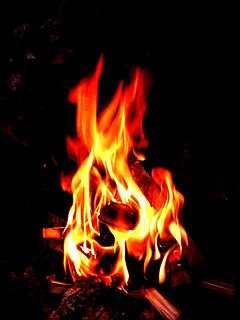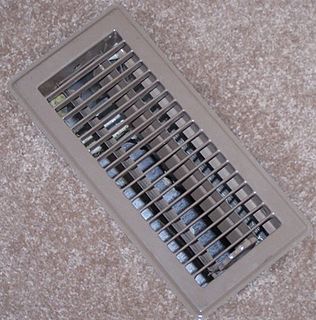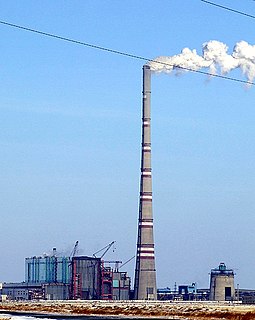Related Research Articles

Combustion, or burning, is a high-temperature exothermic redox chemical reaction between a fuel and an oxidant, usually atmospheric oxygen, that produces oxidized, often gaseous products, in a mixture termed as smoke. Combustion does not always result in fire, because a flame is only visible when substances undergoing combustion vaporize, but when it does, a flame is a characteristic indicator of the reaction. While the activation energy must be overcome to initiate combustion, the heat from a flame may provide enough energy to make the reaction self-sustaining.

A furnace, referred to as a heater or boiler in British English, is an appliance used to generate heat for all or part of a building. Furnaces are mostly used as a major component of a central heating system. Furnaces are permanently installed to provide heat to an interior space through intermediary fluid movement, which may be air, steam, or hot water. Heating appliances that use steam or hot water as the fluid are normally referred to as a residential steam boilers or residential hot water boilers. The most common fuel source for modern furnaces in North America and much of Europe is natural gas; other common fuel sources include LPG, fuel oil, wood and in rare cases coal. In some areas electrical resistance heating is used, especially where the cost of electricity is low or the primary purpose is for air conditioning. Modern high-efficiency furnaces can be up to 98% efficient and operate without a chimney, with a typical gas furnace being about 80% efficient. Waste gas and heat are mechanically ventilated through either metal flue pipes or polyvinyl chloride (PVC) pipes that can be vented through the side or roof of the structure. Fuel efficiency in a gas furnace is measured in AFUE.

The Westinghouse Electric Corporation was an American manufacturing company founded in 1886 by George Westinghouse. It was originally named "Westinghouse Electric & Manufacturing Company", and was renamed "Westinghouse Electric Corporation" in 1945. The company acquired the CBS television network in 1995, and was renamed "CBS Corporation", until being acquired by Viacom in 1999. That merger was completed on April 26, 2000. The CBS Corporation name was later reused for one of the two companies resulting from the split of Viacom in 2006.
Coal gas is a flammable gaseous fuel made from coal and supplied to the user via a piped distribution system. It is produced when coal is heated strongly in the absence of air. Town gas is a more general term referring to manufactured gaseous fuels produced for sale to consumers and municipalities.

Wood fuel is a fuel such as firewood, charcoal, chips, sheets, pellets, and sawdust. The particular form used depends upon factors such as source, quantity, quality and application. In many areas, wood is the most easily available form of fuel, requiring no tools in the case of picking up dead wood, or few tools, although as in any industry, specialized tools, such as skidders and hydraulic wood splitters, have been developed to mechanize production. Sawmill waste and construction industry by-products also include various forms of lumber tailings.

A hot plate is a portable self-contained tabletop small appliance cooktop that features one or more electric heating elements or gas burners. A hot plate can be used as a stand-alone appliance, but is often used as a substitute for one of the burners from an oven range or a kitchen stove. Hot plates are often used for food preparation, generally in locations where a full kitchen stove would not be convenient or practical. They can also be used as a heat source in laboratories. A hot plate can have a flat surface or round surface. Hot plates can be used for traveling or in areas without electricity.
Coal gasification is the process of producing syngas—a mixture consisting primarily of carbon monoxide (CO), hydrogen (H2), carbon dioxide (CO2), methane (CH4), and water vapour (H2O)—from coal and water, air and/or oxygen.

Machine Sazi Arak (MSA) is an Iranian manufacturing corporation that was established in 1967 in an area of 134 hectares in the city of Arak in order to support underlying industries and meet the industrial needs of the country.

A forced-air central heating system is one which uses air as its heat transfer medium. These systems rely on ductwork, vents, and plenums as means of air distribution, separate from the actual heating and air conditioning systems. The return plenum carries the air from several large return grills (vents) to a central air handler for re-heating. The supply plenum directs air from the central unit to the rooms which the system is designed to heat. Regardless of type, all air handlers consist of an air filter, blower, heat exchanger/element/coil, and various controls. Like any other kind of central heating system, thermostats are used to control forced air heating systems.

A flue-gas stack, also known as a smoke stack, chimney stack or simply as a stack, is a type of chimney, a vertical pipe, channel or similar structure through which combustion product gases called flue gases are exhausted to the outside air. Flue gases are produced when coal, oil, natural gas, wood or any other fuel is combusted in an industrial furnace, a power plant's steam-generating boiler, or other large combustion device. Flue gas is usually composed of carbon dioxide (CO2) and water vapor as well as nitrogen and excess oxygen remaining from the intake combustion air. It also contains a small percentage of pollutants such as particulate matter, carbon monoxide, nitrogen oxides and sulfur oxides. The flue gas stacks are often quite tall, up to 400 metres (1300 feet) or more, to increase the stack effect and dispersion of pollutants.

Airflow Sciences Corporation (ASC) is a United States engineering consulting company based in Livonia, Michigan that specializes in the solution of industrial fluid flow problems. While it is particularly known for work in Power generation, its customers come from many industries across a wide geographical regions, and problems are solved using a variety of engineering techniques. Thus, the company is best defined by the type of problems solved, rather than by traditional industry or consultant categories.

Shale oil extraction is an industrial process for unconventional oil production. This process converts kerogen in oil shale into shale oil by pyrolysis, hydrogenation, or thermal dissolution. The resultant shale oil is used as fuel oil or upgraded to meet refinery feedstock specifications by adding hydrogen and removing sulfur and nitrogen impurities.
Meredith Wooldridge Thring, FREng, FIMechE, FIET, FInstP, FIChemE, FEI was a British inventor, engineer, futurologist, professor and author.
A privately held, family-owned U.S. company, Crown Equipment Corporation is the fifth largest manufacturer of powered industrial forklift trucks in the world. Crown had $4.01 billion in worldwide sales revenue for fiscal year 2021. Crown has appeared at least ten times on Forbes’ list of the largest private companies in the United States. In 2021, the company ranked 123rd on that list.
An electric boiler is a device that uses electrical energy to boil water.

Goodman Manufacturing is an American company operating as an independent subsidiary of Daikin Group, the world's largest manufacturer of heating, ventilation and air conditioning products and systems. The company, founded in 1975 and based in Waller, Texas, manufactures residential heating and cooling systems.

Endothermic gas is a gas that inhibits or reverses oxidation on the surfaces it is in contact with. This gas is the product of incomplete combustion in a controlled environment. An example mixture is hydrogen gas (H2), nitrogen gas (N2), and carbon monoxide (CO). The hydrogen and carbon monoxide are reducing agents, so they work together to shield surfaces from oxidation.
Midland-Ross Co. was an American steel, aerospace products, electronics, and automobile components manufacturer which existed from 1894 to 1986.

An industrial furnace, also known as a direct heater or a direct fired heater, is a device used to provide heat for an industrial process, typically higher than 400 degrees Celsius. They are used to provide heat for a process or can serve as reactor which provides heats of reaction. Furnace designs vary as to its function, heating duty, type of fuel and method of introducing combustion air. Heat is generated by an industrial furnace by mixing fuel with air or oxygen, or from electrical energy. The residual heat will exit the furnace as flue gas. These are designed as per international codes and standards the most common of which are ISO 13705 / American Petroleum Institute (API) Standard 560. Types of industrial furnaces include batch ovens, vacuum furnaces, and solar furnaces. Industrial furnaces are used in applications such as chemical reactions, cremation, oil refining, and glasswork.
References
- ↑ Geiger, J.W. (January 1923). "Surface Combustion". Purdue Engineering Review: 11–12.
- ↑ "Personal Notes". American Gas Engineering Journal. November 13, 1920. p. 415.
- 1 2 Battle 2014, p. 278.
- ↑ "Henry O. Loebell Winner of the Munroe Award". Gas Age-Record. November 3, 1934. p. 384.
- 1 2 3 4 5 6 McDonald, Kendrick (June 24, 2015). "Local Firm Still Hot In 100th Year of Heat-Treating Work". Toledo Blade. Retrieved April 5, 2016.
- ↑ "Surface Combustion Co., Inc., Combines With Combustion Utilities Corp". Iron Trade. October 23, 1924. p. 1068.
- ↑ "Control for Doherty Unit". The New York Times. September 19, 1930. p. 39.
- ↑ "Buys Gas Equipment Business". The New York Times. December 3, 1930. p. 42.
- 1 2 Harris 1964, p. 49.
- ↑ "Flying Furnaces". Popular Science: 67. March 1944.
- ↑ Bryan, John E. (November 10, 1959). "Midland-Ross Buys Surface Combustion". The Plain Dealer. p. L33.
- ↑ "Other Sales, Mergers". The New York Times. February 22, 1962. p. 35.
- ↑ Abele, John J. (April 11, 1969). "U.S. Freight Sets Share Acquisition". The New York Times. pp. 63, 67.
- ↑ National Research Council 2007, pp. 19–20.
- 1 2 Sims, Calvin (July 2, 1986). "Forstmann In Deal For Midland-Ross". The New York Times.
- 1 2 3 4 "Surface Combustion: 75 Years of Research". Toledo Blade. August 21, 1990. p. 21. Retrieved April 5, 2016.
- ↑ Ward's Business Directory 1995, p. 4184.
- ↑ "Companhy News: Forstmann Little". The New York Times. March 10, 1988.
- ↑ "Surface Combustion aids international weapons control". Toledo Business Journal. July 1, 2004. Archived from the original on May 5, 2016. Retrieved April 5, 2016; "Port Aids Shipments of Weapons Incinerators" (PDF). The Port of Baltimore. September–October 2010. p. 10. Retrieved April 5, 2016.